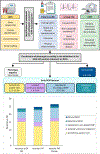Frequency, Penetrance, and Variable Expressivity of Dilated Cardiomyopathy-Associated Putative Pathogenic Gene Variants in UK Biobank Participants
- PMID: 35708014
- PMCID: PMC9375305
- DOI: 10.1161/CIRCULATIONAHA.121.058143
Frequency, Penetrance, and Variable Expressivity of Dilated Cardiomyopathy-Associated Putative Pathogenic Gene Variants in UK Biobank Participants
Abstract
Background: There is a paucity of data regarding the phenotype of dilated cardiomyopathy (DCM) gene variants in the general population. We aimed to determine the frequency and penetrance of DCM-associated putative pathogenic gene variants in a general adult population, with a focus on the expression of clinical and subclinical phenotype, including structural, functional, and arrhythmic disease features.
Methods: UK Biobank participants who had undergone whole exome sequencing, ECG, and cardiovascular magnetic resonance imaging were selected for study. Three variant-calling strategies (1 primary and 2 secondary) were used to identify participants with putative pathogenic variants in 44 DCM genes. The observed phenotype was graded DCM (clinical or cardiovascular magnetic resonance diagnosis); early DCM features, including arrhythmia or conduction disease, isolated ventricular dilation, and hypokinetic nondilated cardiomyopathy; or phenotype-negative.
Results: Among 18 665 individuals included in the study, 1463 (7.8%) possessed ≥1 putative pathogenic variant in 44 DCM genes by the main variant calling strategy. A clinical diagnosis of DCM was present in 0.34% and early DCM features in 5.7% of individuals with putative pathogenic variants. ECG and cardiovascular magnetic resonance analysis revealed evidence of subclinical DCM in an additional 1.6% and early DCM features in an additional 15.9% of individuals with putative pathogenic variants. Arrhythmias or conduction disease (15.2%) were the most common early DCM features, followed by hypokinetic nondilated cardiomyopathy (4%). The combined clinical/subclinical penetrance was ≤30% with all 3 variant filtering strategies. Clinical DCM was slightly more prevalent among participants with putative pathogenic variants in definitive/strong evidence genes as compared with those with variants in moderate/limited evidence genes.
Conclusions: In the UK Biobank, ≈1 of 6 of adults with putative pathogenic variants in DCM genes exhibited early DCM features potentially associated with DCM genotype, most commonly manifesting with arrhythmias in the absence of substantial ventricular dilation or dysfunction.
Keywords: arrhythmias, cardiac; cardiomyopathies; death, sudden, cardiac; genetic testing; genetics; penetrance.
Figures



References
-
- Asatryan B and Medeiros-Domingo A. Translating emerging molecular genetic insights into clinical practice in inherited cardiomyopathies. J Mol Med (Berl). 2018;96:993–1024. - PubMed

